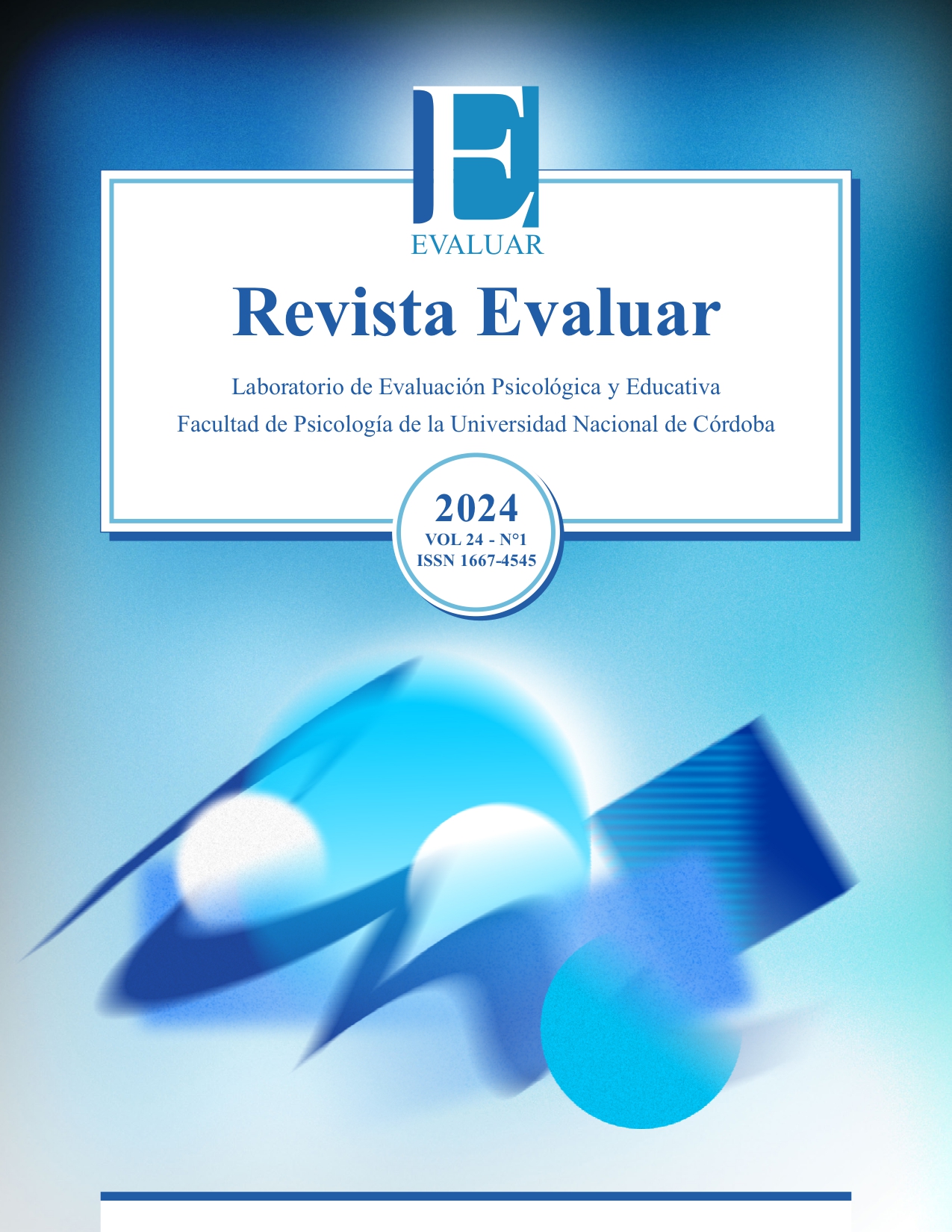Aplicación de un Modelo Exploratorio de Ecuaciones Estructurales para la Evaluación de la “Children and Adolescents Interpersonal Survey” (CAIS)
DOI:
https://doi.org/10.35670/1667-4545.v24.n1.45159Keywords:
CAIS, psychometric properties, interpersonal circumplex model, personalityAbstract
Personality is a complex construct that can be understood from various models. One of the models that has gained importance for its interpretation is the interpersonal circumplex model (IPC). The Children and Adolescents Interpersonal Survey (CAIS) is an instrument specifically developed for the study of this model in children and adolescents. This study aims to examine the psychometric properties of the CAIS in an Argentinean sample of 353 participants. The reliability and validity of the instrument
were analysed. The results of this study indicate adequate internal consistency and item homogeneity, as well as evidence of construct validity (through an exploratory structural equation model) and concurrent validity (through Pearson’s r correlations with another measure of interpersonal traits). Thus establishing the Spanish version of the CAIS as a reliable and valid instrument for the assessment of interpersonal styles in children and adolescents in Argentina.
Downloads
References
Alden, L. E., Wiggins, J. S., & Pincus, A. L. (1990). Construction of circumplex scales for the Inventory of Interpersonal Problems. Journal of personality assessment, 55(3-4), 521–536. https://doi.org/10.1080/00223891.1990.9674088
Areas, M., García-Domench, C., Babl, A., Freiberg-Hoffmann, A., Piazzese Spratte, S., Roussos, A., & Gómez-Penedo, J.M. (2023). Inventory of
Interpersonal Problems-32 (IIP-32): Psychometric Properties in Adolescents from Argentina. Cogent Mental Health, 2(1), 2267590. https://doi.org/10.1080/28324765.2023.2267590
Auerbach, R. P., Ho, M. H. R., & Kim, J. C. (2014). Identifying cognitive and interpersonal predictors of adolescent depression. Journal of Abnormal ChildPsychology, 42(6), 913–924. https://doi.org/10.1007/s10802-013-9845-6
Bailey, C., Abate, A., Sharp, C., & Venta, A. (2018). Psychometric evaluation of the Inventory of Interpersonal Problems 32. Bulletin of the Menninger Clinic, 82(2), 93–113. https://doi.org/10.1521/bumc.2018.82.2.93
Barbaranelli, C., Caprara, G. V., Rabasca, A., & Pastorelli, C. (2003). A questionnaire for measuring the big five in late childhood. Personality and Individual Differences, 34, 645–664. https://doi.org/10.1016/S0191-8869(02)00051-X
Cloninger, C.R., Svrakic, D.M., & Przybeck, T.R. (1993). A psychobiological model of temperament and character. Archives of General Psychiatry, 39, 1242–1247.
DiRico, E., Paternain, N., Portillo, N., & Galarza, A. L. (2016). Análisis de la relación entre factores interpersonales y riesgo suicida en adolescentes de la ciudad de Necochea. Perspectivas en Psicología: Revista de Psicología y Ciencias Afines, 13(2), 95–106. Análisis de la relación entre factores interpersonales y riesgo suicida en adolescentes de la ciudad de Necochea (redalyc.org)
Dominguez-Lara, S., & Merino-Soto, C. (2018). Estructura interna del BFI-10P y BFI-15P: Un estudio complementario con enfoque CFA y ESEM. Revista Argentina de Ciencias del Comportamiento, 10(3), 22-34. Recuperado de https://revistas.unc.edu.ar/index.php/racc/article/view/21037
Elosua, O. P., & Zumbo, B. D. (2008). Coeficientes de fiabilidad para escalas de respuesta categórica ordenada. Psicothema, 20(4), 896-901. Redalyc. Coeficientes de fiabilidad para escalas de respuesta categórica ordenada.
Eysenck, H.J. (1991). Dimensions of personality: 16, 5 or 3? Criteria for a taxonomic paradigm. Personality and Individual Differences, 12, 773–790.
Freiberg-Hoffmann, A., Stover, J. B., de la Iglesia, G., & Fernández Liporace, M. (2013). Correlaciones policóricas y tetracóricas en estudios factoriales exploratorios y confirmatorios. Ciencias Psicológicas, 7(2), 151-164. https://doi.org/10.22235/cp.v7i1.1057
Gadermann, A. M., Guhn, M., & Zumbo, B. D. (2012). Estimating ordinal reliability for Likert-type and ordinal item response data: A conceptual, empirical, and practical guide. Practical Assessment, Research and Evaluation, 17(3), 1-13. https://doi.org/10.7275/n560-j767
Gómez-Penedo, J. M., Fernández-Álvarez, J., Maristany, M., & Freiberg-Hoffmann, A. (2022). Inventory of Interpersonal Problems-32 (IIP-32): Psychometric properties and normative data in a clinical sample from Argentina. Revista Evaluar, 22(2), 64-75. http://dx.doi.org/10.35670/1667-4545.v22.n2.38688
Goodwin, L.D., & Leech, N.L. (2006). Understanding Correlation: Factors That Affect the Size of r. The Journal of Experimental Education, 74(3), 249-266, https://doi.org/10.3200/JEXE.74.3.249-266
Grosse-Holtforth, M., Altenstein, D., Krieger, T., Flückiger, C., Wright, A. G., & Caspar, F. (2014). Interpersonal differentiation within depression diagnosis: Relating interpersonal subgroups to symptom load and the quality of the early therapeutic alliance. Psychotherapy Research, 24(4), 429-441. https://doi.org/10.1080/10503307.2013.829253
Guay, F., Morin, A. J. S., Litalien, D., Valois, P., & Vallerand, R. J. (2015). Application of Exploratory Structural Equation Modeling to Evaluate the Academic Motivation Scale. The Journal of Experimental Education, 83(1), 51-82. https://doi.org/10.1080/00220973.2013.876231
Horowitz, L. M. (2004). Interpersonal Foundations of Psychopathology. Washington, DC: American Psychological Association. https://doi.org/10.1037/10727-000
Horowitz, L. M., Alden, L. E., Wiggins, J. S., & Pincus, A.L. (2000). IIP, Inventory of Interpersonal Problems Manual. San Antonio: The Psychological Corporation.
Horowitz, L. M., Rosenberg, S. E., Baer, B. A., Ureño, G., & Villaseñor, V. S. (1988). Inventory of Interpersonal Problems: Psychometric properties
and clinical applications. Journal of Consulting and Clinical Psychology, 56(6), 885-892. https://doi.org/10.1037/0022-006X.56.6.885
Inglés, C. J., Hidalgo, M. D., & Méndez, F. X. (2005). Interpersonal difficulties in adolescence: A New self-report measure. European Journal of
Psychological Assessment, 21(1), 11–22. https://doi.org/10.1027/1015-5759.21.1.11
Jensen-Campbell, L. A., Adams, R., Perry, D. G., Workman, K. A., Furdella, J. Q., & Egan, S. (2002). Agreeableness, extraversion, and peer relations in early adolescence: Winning friends and deflecting aggression. Journal of Research in Personality, 36, 224–251.
John, O.P., & Srivastava, S. (1999). The Big Five trait taxonomy: History, measurement, and theoretical perspectives. In L.A. Pervin & O.P. John (Eds.), Handbook of personality: Theory and research (2nd Ed., pp. 102–138). New York: Guilford.
Jöreskog, K., & Sörbom, D. (1993). LISREL 8 [Computer software]. Chicago, IL: Scientific Software International, Inc. Recuperado de https://ssicentral.com
Leary, T. (1957). Interpersonal diagnosis of personality. New York: Ronald.
Li, C.H. (2016). The performance of ML, DWLS, and ULS estimation with robust corrections in structural equation models with ordinal variables. Psychological Methods, 21, 369-87. http://doi.org/10.1037/met0000093
Lubinski, D. (2000). Scientific and social significance of assessing individual differences: ‘Sinking shafts at a few critical points’. Annual Review of Psychology, 51, 405–444.
Maristany, M. (2005). Problemas en las relaciones interpersonales y trastornos de la personalidad. Universidad de Belgrano. Recuperado de http://repositorio.ub.edu.ar
McCrae, R.R., & Costa, P.T., Jr. (1999). A five-factor theory of personality. In L.A. Pervin & O.P. John (Eds.), Handbook of personality theory and research (pp. 139–153). New York: Guilford.
Mindrila, D. (2010). Maximum likelihood (ML) and diagonally weighted least squares (DWLS) estimation procedures: A comparison of estimation bias with ordinal and multivariate non-normal data. International Journal of Digital Society, 1(1), 60-66. https://doi.org/10.20533/ijds.2040.2570.2010.0010
Mónaco, E., de la Barrera, U., & Montoya-Castilla, I. (2021). Parents and peer attachment and their relationship with emotional problems in adolescence is stress mediating? Revista de Psicología Clínica con Niños y Adolescentes, 8(3), 67-73. http://dx.doi.org/10.21134/rpcna.2021.08.3.8
Moreno-Peral, P., Bellón, J. A., Huibers, M. J. H., Mestre, J. M., García-López, L. J., Taubner, S., Rodríguez-Morejón, A., Bolinski, F., Sales, C. M. D., & Conejo-Cerón, S. (2020). Mediators in psychological and psychoeducational interventions for the prevention of depression and anxiety. A systematic review. Clinical Psychology Review, 76, 101813. https://doi.org/10.1016/j.cpr.2020.101813
Muthén, L. K., & Muthén, B. O. (2017). Mplus: Statistical Analysis with Latent Variables: User’s Guide (Version 8). Los Angeles, CA: Authors.
Rattray, J., & Jones, M. C. (2007). Essential elements of questionnaire design and development. Journal of Clinical Nursing, 16, 234–243. https://doi.org/10.1111/j.1365-2702.2006.01573.x
Rial-Boubeta, A., Varela-Mallou, J., Abalo-Piñeiro, J., & Lévy-Mangin, J. P. (2006). El análisis factorial confirmatorio. In J. P. L. M. En y J. Varela (Eds.), Modelización con estructuras de covarianzas en ciencias sociales (pp. 119–143). Recuperado de BERITA 2024 – Berita Terupdate 2024 (netbiblo.com)
RStudio Team (2020). RStudio: Integrated Development for R. RStudio, PBC, Boston, MS. Retrieved July, 7th, 2023, from http://www.rstudio.com
Schumacker, R. E., & Lomax, R. G. (2016). A beginner’s guide to structural equation modeling (4th Ed.). Psychology press. https://doi.org/10.4324/9781410610904
Shiner, R., & Caspi, A. (2003). Personality differences in childhood and adolescence: measurement, development, and consequences. Journal of Children Psychology and Psychiatry, 44(1), 2-32. https://doi.org/10.1111/1469-7610.00101
Sodano, S.M., & Tracey, T.J.G. (2006). Interpersonal Traits in Childhood: Development of the Child and Adolescent Interpersonal Survey. Journal of Personality Assessment, 87, 3, 317-329. https://doi.org/10.1207/s15327752jpa8703_12
Sodano, S.M. (2011). Integrating vocational interests, competencies, and interpersonal dispositions in middle school children. Journal of Vocational Behavior, 79(1), 110-120. https://doi.org/10.1016/j.jvb.2010.12.013
Sullivan, H. S. (1953). The interpersonal theory of psychiatry. New York: Norton.
Tavakol, M., & Dennick, R. (2011). Making sense of Cronbach alpha. International Journal of Medical Education, 2, 53-55. https://doi.org/10.5116/ijme.4dfb.8dfd
Taubner, S., Ioannou, Y., Saliba, A., Sales, C., Volkert, J., Protić, S., Adler, A., Barkauskiene, R., Conejo-Cerón, S., DiGiacomo, D., Mestre, J. M., Moreno-Peral, P., Mucha-Vieira, F., Pinheiro-Mota, C., Rangel-Santos-Henriques, M. I., Røssberg, J. I., Perdih, T. S., Schmidt, S. J., & Heinonen, E. (2023). Mediators of outcome in adolescent psychotherapy and their implications for theories and mechanisms of change: A systematic review. European Children and Adolescent Psychiatry. https://doi.org/10.1007/s00787-023-02186-9
Tellegen, A. (1985). Structure of mood and personality and their relevance to assessing anxiety, with an emphasis on self-report. In A.H. Tuma & J.D. Maser (Eds.), Anxiety and the anxiety disorders (pp. 681–706). Hillsdale, NJ: Erlbaum.
Trógolo, M. A., Montes, S. A., & Ledesma, R. D. (2022). Adaptación argentina del Personality Inventory for DSM-Brief Form (PID-5-BF): Un análisis ESEM. Revista Evaluar, 22(3), 20-34. Recuperado de https://revistas.unc.edu.ar/index.php/revaluar
Wiggins, J. S. (1979). A psychological taxonomy of trait-descriptive terms: The interpersonal domain. Journal of Personality and Social Psychology, 37(3), 395–412. https://doi.org/10.1037/0022-3514.37.3.395
Wiggins, J. S. (1982). Circumplex models of interpersonal behavior in clinical psychology. In P. C. Kendall & J. N. Butcher (Eds.), Handbook of research methods in clinical psychology (pp. 183–221). New York: Wiley.
Wiggins, J. S. (1995). IAS: Professional manual. Tampa, FL: Psychological Assessment Resources.
Zumbo, B. D., Gadermann, A. M., & Zeisser, C. (2007). Ordinal versions of coefficients alpha and theta for Likert rating scales. Journal of Modern Applied Statistical Methods, 6(1), 21-29. https://doi.org/10.22237/jmasm/1177992180
Downloads
Published
How to Cite
Issue
Section
License
Copyright (c) 2024 Malenka Areas, Candela García-Domench, Agustin Freiberg-Hoffmann, Andrés Roussos, Juan Martín Gómez-Penedo

This work is licensed under a Creative Commons Attribution 4.0 International License.
Revista Evaluar aplica la Licencia Internacional de Atribuciones Comunes Creativas (Creative Commons Attribution License, CCAL). Bajo esta licencia, los autores retienen la propiedad de copyright de los artículos pero permiten que, sin que medie permiso de autor o editor, cualquier persona descargue y distribuya los artículos publicados en Evaluar. La única condición es que siempre y en todos los casos se cite a los autores y a la fuente original de publicación (i.e. Evaluar). El envío de artículos a Evaluar y la lectura de los mismos es totalmente gratuito.




_(3).jpg)



.jpg)



